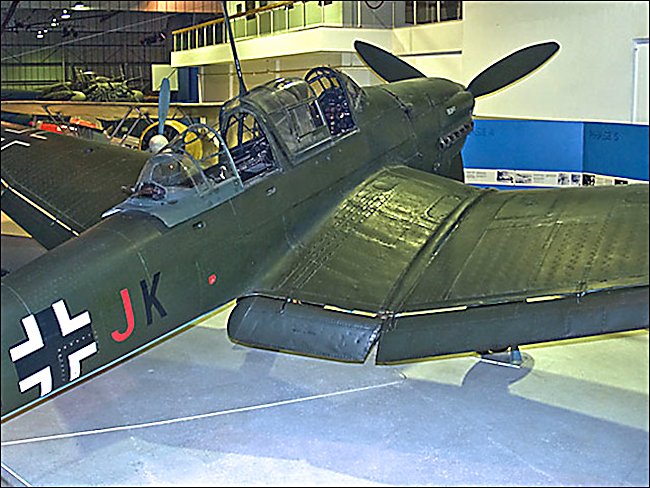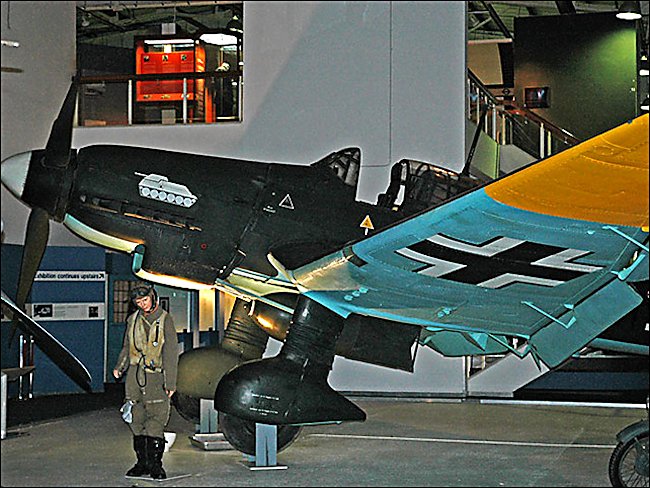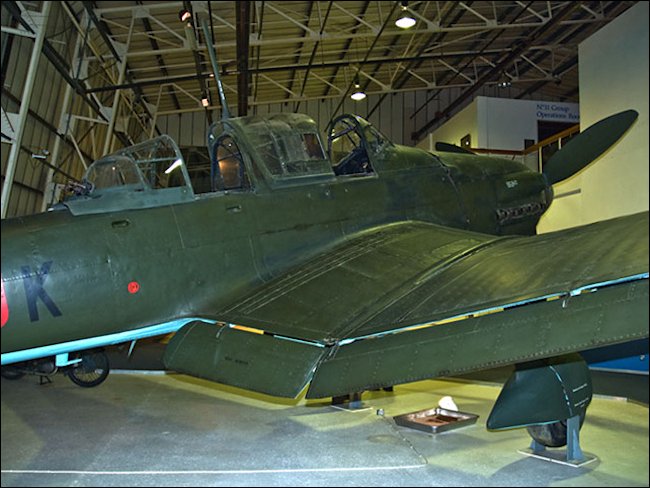Junkers JU87 Stuka dive bomber
I really wish to see a JU87 Stuka flying again at an airshow. New ME262s have been built and are flying. A next great project for someone with the money, time and the necessary skills would be to build and fly a Stuka to make history come back to life. The WW2 German Lufftwaffe Junkers JU87 Stuka pilot Hans-Ulrich Rudel was the only pilot in WW2 ever to be awarded the German Knights Cross to the Iron Cross with Oak Leaves, Swords and Diamonds. He had flown 2,530 operational flights and had destroyed over 500 Russian tanks and a Russian battleship. He also committed several acts of great bravery, including landings in enemy territory and in the battlefield to rescue downed comrades by taking them back in the small cockpit of the Stuka.
The Junkers Ju87 known as the dive bomber "Sturzkampfbomber" to the Germans and better known to the English as the "Stuka" dive-bomber was responsible for the sinking of many ships and the destruction of thousands of tanks during the second world war. The famous scream of its 'Trumpets of Jericho' sirens that activated as it dived helped to spread terror amongst both soldiers and civilians.

Photograph taken at the RAF Museum, Hendon, London NW9 5LL England
The Junkers JU87 Stuka Dive Bomber had distinctive gull-wings to allow it to dive directly onto its target at a steep angle to obtain high hit rates. Straight wings would have been ripped off by the amount of stress put on them. These inverted gull wings limited the speed of the aircraft to about 255 mph (410 km/h) in normal flight. The Junkers Ju87 Stuka normally carried one 250 kg bomb, increased later to a 500 kg bomb, under the fuselage. It could also carry four 50kg bombs under the wings. It had a slow maximum speed of 195 mph (314 kph) with a cruising speed of 118 mph (190 kph). It had a range of only 199 miles (320 kms). They were designed to fly directly overhead their target, then dive bombing at an angle of almost 90 degrees.

Photograph taken at the RAF Museum, Hendon, London NW9 5LL England
In an air superiority situations that existed in the campaigns in Spain (1936 to 1939), Poland and the Low Countries, Junkers Ju87 Stuka were devastating. With little aerial opposition it was able to attack targets with great accuracy. There were over 300 Stukas in service by the invasion of Poland. The Luftwaffe achieved air superiority during the invasion of Belgium, France and Holland. The Ju87 Stukas were like flying artillery, but with far greater range and flexibility. They attacked Allied divisions behind the front catching French heavy tanks still on their railway cars. But over France, there were a number of disasters. One flight (staffel) was shoot down by five French fighters on 12 May 1940. they had a 100 mph speed advantage and were armed with 20-mm cannon. These French fighters made short work of the lumbering and unmanoeuvrable Stukas.
After the fall of France it was at used to attack shipping in the Channel. The Ju87 went on to sink more ships than any other aircraft in history. During the initial period of the Battle of the Britain German tactic were to knock out the British Radar sites on the south coast and then bomb the RAF air fields. The Ju87 Stukas made an impact on the Radar bases but they were soon rebuilt. The Junkers Ju87 Stuka meet their match over the English Channel during the Battle of Britain. They could not compete against the superior RAF fighters like the Hurricane and Spitfire. The slow top speed of the aircraft and the poor rate of climb that was to be the downfall of the Ju87. The losses could not be maintained so the German high command with drew them from campaigns in Western Europe for the rest of the war.

Photograph taken at the RAF Museum, Hendon, London NW9 5LL England
New variants were produced and the Ju87 Stuka saw service in Europe and the Mediterranean. A limited numbers of Stukas served in North Africa and the Italian campaign. At the beginning of Operation Barbarossa, the German attack on Russia the Luftwaffe outclassed the Red Airforce. For a short period of time in these favourable air supremacy situation, the Stuka proved a very successful tank buster on the Russian Eastern Front. By 1943 the Russian Airforce had been re-equipped with advanced fighters like the Stormaviks British Hawker hurricanes sent out in Arctic convoys. It was a repeat of the Battle of Britain. The Junkers JU-87 Stuka again fell victim to more advanced, manoeuvrable and faster fighter planes. It could not operate without fighter cover from then on.
Dive bombing remained the precision bombing method of choice even after World War Two until it was gradually replaced by rockets, guided missiles and bombs when precision air attacks were required. By the end of World War Two over 5,700 Junkers JU-87 Stukas had been built. The Junkers JU-87 Stuka dive-bomber supported advancing columns of German tanks during their Blitzkrieg attacks on Poland, Belgium and France. They provided "airborne support artillery" for the ground troops and could take on and neutralise tanks, fortified hardened positions, machine guns. The could also cut roads, blow up bridges, destroy supply convoys, sink ships, attack ground infantry and artillery units.

Photograph taken at the RAF Museum, Hendon, London NW9 5LL England
Combat experience in Russia demonstrated that hitting a tank with a heavy bomb was next to impossible even for a Stuka. On the Russian front the standard anti-tank weapon was the SD-4-H1 a 4 kg hollow-charge bomblet. Seventy eight were carried inside a 500 kg bomb case. The bomblets could penetrate the thin top armour of any Allied tank-even the massive JS-2s used by the Red Army's in 1945.More spectacular but fraught with danger for the aircrew was one of the final Stuka models : the Ju 87G-1. Introduced in 1943 , this carried a pair of 37-mm cannon which could also penetrate the top armour of a tank but the weight and drag further reduced the Stuka's already marginal performance.
Famous German Ace, Hans-Ulrich Rudel, flew Stukas. Rudel helped develope the 'tank busting' Ju 87G and claimed 519 tank 'kills' by the end of the war. It was not until mid-1943 that German bombers were seriously menaced by Soviet fighters. The Russians by then had RADAR and could direct their fighters to intercept. Stukas continued to operate in large numbers-over 500 of them attacked the Soviet bridgehead near Novorossiysk in April 1943.Ju 87s were supplied to allied air forces of Romania , Italy , Hungary and Bulgaria.Stuka production peaked that year at 1,814 units.Some 5,700 were completed before production ceased in 1944.

Photograph taken at the RAF Museum, Hendon, London NW9 5LL England
Famous German Ace, Hans-Ulrich Rudel, flew Stukas. Rudel helped develope the 'tank busting' Ju 87G and claimed 519 tank 'kills' by the end of the war. It was not until mid-1943 that German bombers were seriously menaced by Soviet fighters. The Russians by then had RADAR and could direct their fighters to intercept. Stukas continued to operate in large numbers-over 500 of them attacked the Soviet bridgehead near Novorossiysk in April 1943.Ju 87s were supplied to allied air forces of Romania , Italy , Hungary and Bulgaria.Stuka production peaked that year at 1,814 units.Some 5,700 were completed before production ceased in 1944.
The German military had developed and practiced their new and revolutionary Blitzkrieg (lightning war) tactic before World War 2. The Stuka Dive Bomber was one of the airborne element of the Blitzkrieg. One of the requirement of a Blitzkrieg aircraft was its ability to and take off from primitive unprepared front line airfields thus allowing them to stay close to the rapidly advancing German ground forces. The Junkers JU-87 Stuka was designed with a strong fixed landing gear with front wheel covers rather than weaker retractable undercarriage. This enabled the Stuka JU 87 to fly up to ten short-range attack sorties every day as it was nearer the advancing front line. It was much more efficient than a normal tactical support fighter bomber that had to operate from more conventional airfields further back from the front line. They wasted time flying longer distances to and from the target.

Photograph taken at the RAF Museum, Hendon, London NW9 5LL England
Under the terms of the Versailles Treaty Germany was not allowed to have an air force , but within months of coming to power Hitler announced he would no longer be bound by this restriction. The Stuka was designed by Hans Pohlmann for Junkers. It was the first purpose built dive bomber. It was called the Junkers K47 and flew for the first time in March 1928. Only fourteen were built. Research showed that such dive bombers were and effective army close support weapon. Concentrated aerial bombardment could be used to pave the way for mechanized troops and infantry through enemy lines and hit moving ships with better accuracy than a conventional bomber.
The prototype of the Ju87 Stuka had a fixed undercarriage and a radical gull-wing appearance. It was powered by a British Rolls-Royce Kestrel engine, which was a rather strange choice. It made its first flight in May 1935. The first variant was the Ju87A-1 and had dive brakes added to the outer wings, the kestrel engine was replaced by a Jumo 210Ca 640 horsepower engine which drove a variable pitch three bladed propeller, and a single tail fin replaced the twin fins of the original design. The Ju87A-2 variant was given larger fairings over the landing gear and 680 hp Jumo 210Da engine. Both the Ju87A-1 and Ju87A-2 were delivered to StG163 squadron which saw action with the fascist Condor legion in Spain in support of the Spanish Nationalist forces. By early 1939, all the A series were sent to training units and all the Stukageschwader were equipped with the more powerful Ju87B series that had been given the more powerful Jumo 211A direct injection engine that produced 1,200hp. It had more streamlined spats over the landing gear and an automatic dive control.
The pilot high G-suit had not yet invented then. There was a danger that pilots executing a high dive and pull out could temporarily lose consciousness because of the high G force and crash to the ground. The German aircraft designers invented an autopilot system that automatically turned the Stuka into a near vertical dive when the dive-break controls were switched on. The system then automatically pulled the aircraft out of the dive and back to level flight when the bomb was dropped. The Junkers JU-87 Stuka dive-bomber was a very stable aircraft making it easier to aim the bomb. The Stuka pilot could focus entirely on precise aiming during the fast steep dive due to the pilot's good view from the cockpit and the special indicators that informed him when he reached the optimal bomb release altitude.
The screaming siren attached to the fixed wheel covers of Junkers JU-87 Stuka dive-bomber that terrorised enemy civilians and soldiers alike, was ordered to be fitted by Hitler. He wanted to make his dive bombers more frightening and psychological disturbing. Whistles were also fitted onto the fins of the bombs to ensure that their victims knew just when the bombs were released and could track them on the way down. At the beginning of the war the Junkers JU-87 Stuka carried 700kg of bombs but latter this increased to a big 1800kg (4000lb) bomb. (The modern F-117 stealth fighter carries a similar bomb load),It also had two light machine guns operated by a rear gunner but these were not effective enough against fighters. The rear gunner, the pilot and the plane were not protected from ground fire or enemy fighters as the aircraft did not have any armour.
To counter the mass regiments of Russian tanks, a new version of the Junkers Stuka was developed, the Junkers Ju-87 G. It was no longer designed as a dive bomber. Instead it was armed with two 30mm anti-tank cannons in pods under the wings and a 7.92mm machine gun in the back for the gunner. It was given the roll of tank buster. These guns were not effective against the frontal thick armour of Russian tanks. The Luftwaffe Pilots developed the tactic of hitting the tanks from the side, rear or on the top where the amour was much thinner. The stuka had found a new role so long as it was protected by a combat air patrol (CAP) of friendly fighters. It was the German equivalent of the Russian Sturmovik. It had reduced speed and range was due to the armour plating installed to protect the pilot and gunner when flying low-level tank busting missions.
JU87 Stuka books


Tweet